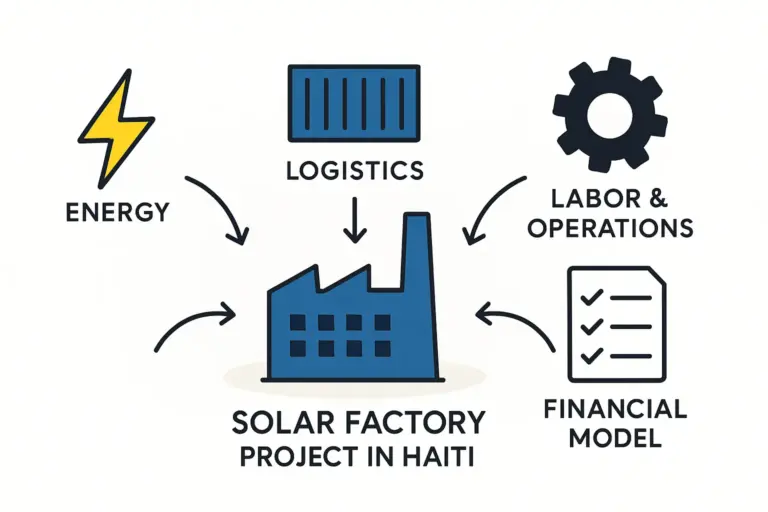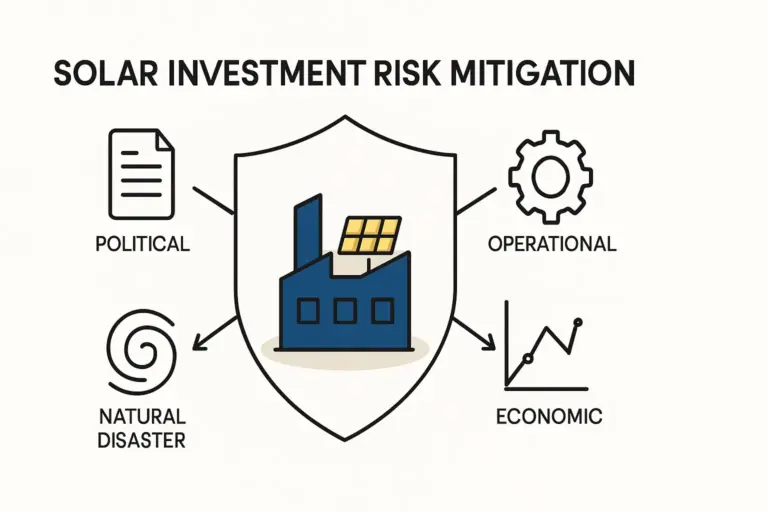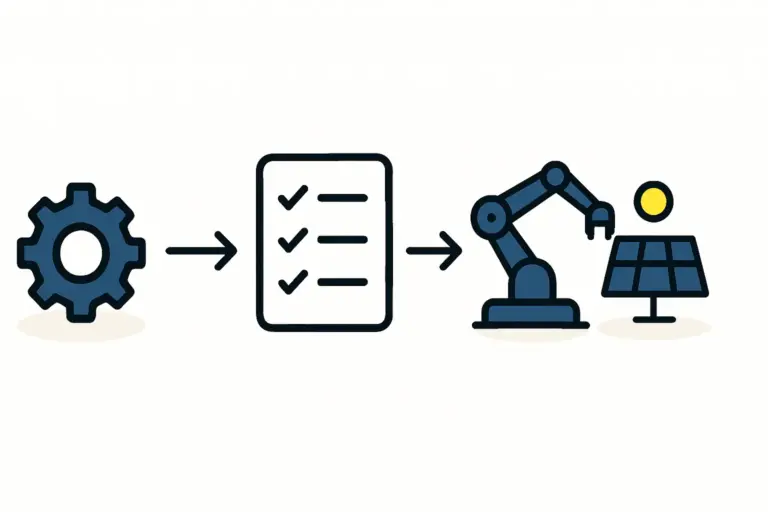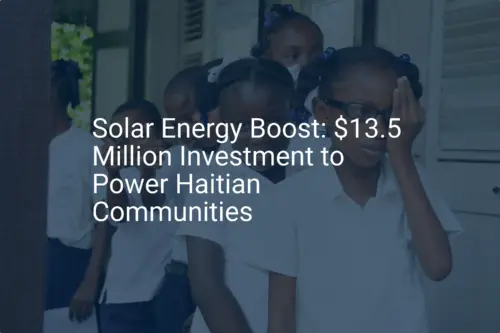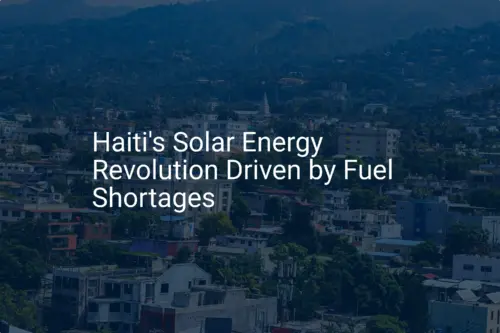Imagine your newly commissioned solar module production line, equipped with state-of-the-art machinery, grinds to a sudden halt. The lights go out, the conveyors stop, and a half-finished module is now potentially ruined inside the laminator.
This isn’t a hypothetical scenario; for any industrial enterprise in Haiti, this is a daily operational risk. The very asset intended to bring energy independence to others must first secure its own.
For entrepreneurs considering a solar module production line in Haiti, the national power infrastructure presents a formidable challenge. With the average electricity customer experiencing over 1,800 hours of power outages annually—equivalent to 78 full days of downtime—relying on the national grid is not a viable option for a sensitive, 24/7 manufacturing operation.
This article outlines the power supply dilemma and offers practical, reliable solutions for ensuring operational continuity.
The Power Dilemma in Haiti’s Industrial Sector
Haiti’s energy landscape is marked by a combination of low access, high costs, and profound unreliability. Only about 45% of the population has access to electricity, and the state utility, Electricité d’Haïti (EDH), faces significant operational and financial hurdles.
This reality has direct consequences for any business owner:
-
Extreme Unreliability: The grid is down approximately 21% of the time. For a manufacturing facility, this translates directly into lost revenue, production delays, and failure to meet supply commitments.
-
High and Volatile Costs: At an average of $0.25/kWh, grid electricity is already more expensive than the regional average. This cost is heavily influenced by the country’s reliance on imported fossil fuels, making it subject to global price volatility.
-
Equipment Risk: Sudden power cuts and voltage fluctuations can damage sensitive and expensive manufacturing equipment, leading to costly repairs and extended downtime.
A solar module factory cannot function, let alone be profitable, under these conditions. A dedicated, independent power solution is not an optional extra—it is a core component of the business plan.
Viable Power Solutions for Operational Continuity
To guarantee the stable, high-quality power a solar factory requires, investors must plan for a captive power plant. This means generating electricity on-site, independent of the national grid. The most common and effective solutions fall into three main categories.
Solution 1: The Standalone Diesel Generator System
The traditional approach for many Haitian businesses has been to rely entirely on diesel generators. While this technology is well-understood, it presents significant long-term challenges for a large industrial user.
Pros: Proven technology, relatively straightforward to install.
Cons: Extremely high and unpredictable operating costs due to diesel fuel price fluctuations, intensive maintenance requirements, noise and air pollution, and logistical challenges related to fuel storage and delivery.
For a power-intensive operation like a solar factory, relying solely on diesel creates massive exposure to fuel price shocks that can erode profitability overnight.

Solution 2: The Captive Solar-plus-Storage System
A more modern and economically sustainable solution leverages Haiti’s greatest natural resource: the sun. The country boasts an average daily solar irradiation of 5 kWh/m², making it an ideal location for solar power generation. This system involves a large solar PV array (either on the factory roof or ground-mounted) paired with a Battery Energy Storage System (BESS).
This setup operates as a self-contained microgrid for the factory:
-
Daytime Operation: The solar array directly powers the entire production line.
-
Energy Storage: Excess solar energy generated during peak sun hours is used to charge the battery bank.
-
Night/Cloudy Operation: The factory draws power from the charged batteries, ensuring seamless 24-hour operation without interruption.
This approach offers energy independence and predictable, low operating costs after the initial investment.
Solution 3: The Integrated Hybrid Approach (Solar + Storage + Generator)
For the highest level of reliability, a hybrid system offers the most robust solution. It combines the economic benefits of solar with the on-demand assurance of a backup generator.
Primary Power: The solar-plus-storage system runs the factory over 95% of the time.
Backup Power: A significantly smaller diesel generator is integrated into the system. It is programmed to automatically start only during extended periods of cloudy weather or when the battery system is undergoing maintenance.
This integrated model dramatically reduces diesel consumption and costs while providing an ultimate failsafe, guaranteeing 100% operational uptime.

Analyzing the Financial Implications
While a captive power plant requires a significant upfront expenditure, it is crucial to analyze it through the lens of Total Cost of Ownership (TCO) and risk mitigation. The high operational expenses of a diesel-only system can quickly surpass the initial capital cost of a solar-plus-storage solution.
A key metric is the Levelized Cost of Energy (LCOE), which represents the average total cost to build and operate a power source over its lifetime, divided by its total energy output.
As the data shows, while the initial investment for solar-plus-storage is highest, its LCOE becomes the most favorable over time due to the absence of fuel costs. This transforms electricity from a volatile variable cost into a predictable, fixed expense, making long-term financial planning significantly more accurate.
Planning Considerations for Your Power System
Integrating an independent power system is a complex engineering task that must be addressed in the earliest stages of planning.
-
Load Analysis: The first step is a detailed analysis of the factory’s projected electricity consumption. This includes the power requirements of each machine, the production schedule, and peak demand cycles.
-
System Sizing: Based on the load analysis, engineers can accurately size the solar array, battery bank, and any backup generators. Undersizing leads to production stoppages, while oversizing results in unnecessary capital expenditure.
-
Physical Integration: The power system must be integrated into the factory’s building and layout. This includes allocating sufficient roof or land area for solar panels and a secure, climate-controlled space for batteries and inverters. Experience from J.v.G. turnkey projects shows that planning this integration from day one prevents costly retrofitting later.
-
Scalability: The system should be designed with future expansion in mind, allowing for the addition of more solar capacity or batteries as the factory grows.
Frequently Asked Questions (FAQ)
How much space is needed for a captive solar system?
The required area depends directly on the factory’s energy consumption. For a smaller 20-50 MW annual production line, a rooftop area of 3,000 to 6,000 square meters may be sufficient. Larger facilities might require an adjacent plot of land for a ground-mounted system.
What is the typical lifespan of a solar and battery system?
Modern solar panels have a performance warranty of 25 years or more. Industrial-grade battery systems typically have a lifespan of 10-15 years or a specific number of charge cycles, depending on the technology and usage patterns.
Can this power system also supply energy to the local community?
While technically possible to export surplus energy, this introduces significant regulatory, legal, and operational complexities. For a new manufacturing venture, the primary focus should be on guaranteeing 100% reliable power for the factory’s own operations.
Is financing available for such power systems in Haiti?
Financing for large-scale renewable energy projects in emerging markets is a known challenge. However, institutions like the World Bank, Inter-American Development Bank, and various international climate funds are increasingly active in this space. A well-structured business plan with a robust energy strategy is essential to securing such funding.

The Path Forward
Securing a reliable power supply is arguably the most critical infrastructure challenge when planning a solar factory in Haiti. The national grid is not a dependable option for an industrial operation. A dedicated, on-site power generation system—ideally a hybrid of solar, battery storage, and a backup generator—is a foundational requirement for success.
This investment transforms electricity from an unpredictable risk into a managed, long-term asset. While the planning is complex, the solutions are proven. Understanding these requirements is a vital first step for any entrepreneur serious about setting up a solar module production line in the region.


